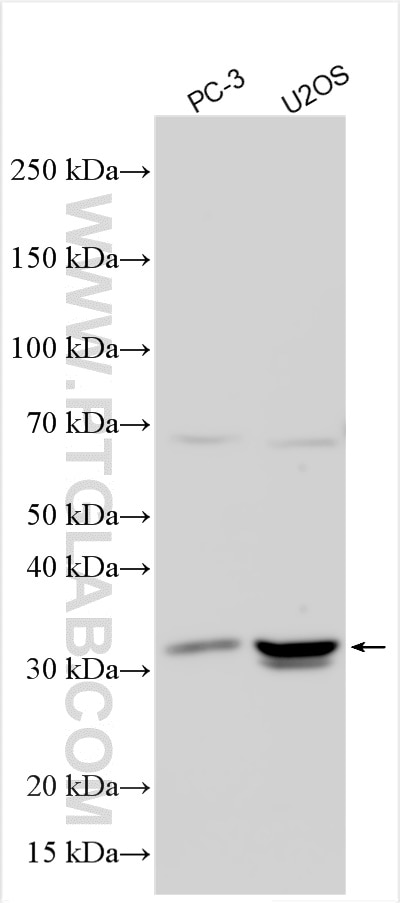Tested Applications
| Positive WB detected in | PC-3 cells, U2OS cells |
Recommended dilution
| Application | Dilution |
|---|---|
| Western Blot (WB) | WB : 1:1000-1:4000 |
| It is recommended that this reagent should be titrated in each testing system to obtain optimal results. | |
| Sample-dependent, Check data in validation data gallery. | |
Product Information
26799-1-AP targets ZIP1 in WB, ELISA applications and shows reactivity with human samples.
| Tested Reactivity | human |
| Host / Isotype | Rabbit / IgG |
| Class | Polyclonal |
| Type | Antibody |
| Immunogen | ZIP1 fusion protein Ag24937 Predict reactive species |
| Full Name | solute carrier family 39 (zinc transporter), member 1 |
| Calculated Molecular Weight | 324 aa, 34 kDa |
| Observed Molecular Weight | 34 kDa |
| GenBank Accession Number | BC003152 |
| Gene Symbol | SLC39A1 |
| Gene ID (NCBI) | 27173 |
| RRID | AB_3669568 |
| Conjugate | Unconjugated |
| Form | Liquid |
| Purification Method | Antigen affinity purification |
| UNIPROT ID | Q9NY26 |
| Storage Buffer | PBS with 0.02% sodium azide and 50% glycerol , pH 7.3 |
| Storage Conditions | Store at -20°C. Stable for one year after shipment. Aliquoting is unnecessary for -20oC storage. 20ul sizes contain 0.1% BSA. |
Background Information
SLC39A1, also known as ZIP1, is a member of the zinc-iron permease family. It is localized to the cell membrane and acts as a zinc uptake transporter. SLC39A1 mediates the influx of Zn2+ into cells from extracellular space(PMID: 16844077).SLC39A1 is the major importer of zinc from circulating blood plasma into prostate cells (PMID: 12888280). In mesenchymal stem cells (MSCs), ZIP1 may exist as a dimer with a molecular weight of 70kD(PMID:16203195).
Protocols
| Product Specific Protocols | |
|---|---|
| WB protocol for ZIP1 antibody 26799-1-AP | Download protocol |
| Standard Protocols | |
|---|---|
| Click here to view our Standard Protocols |



